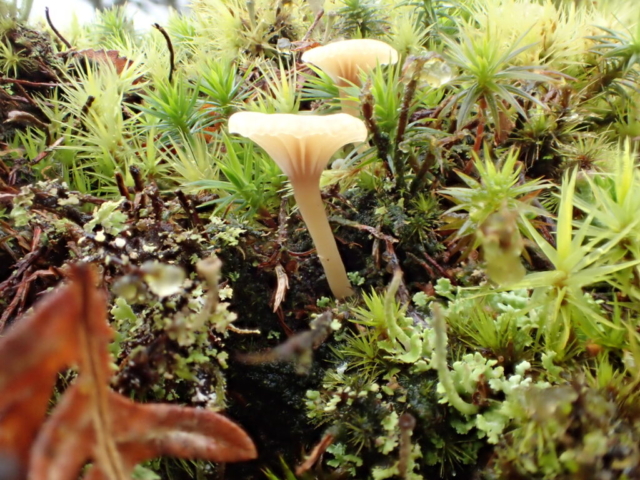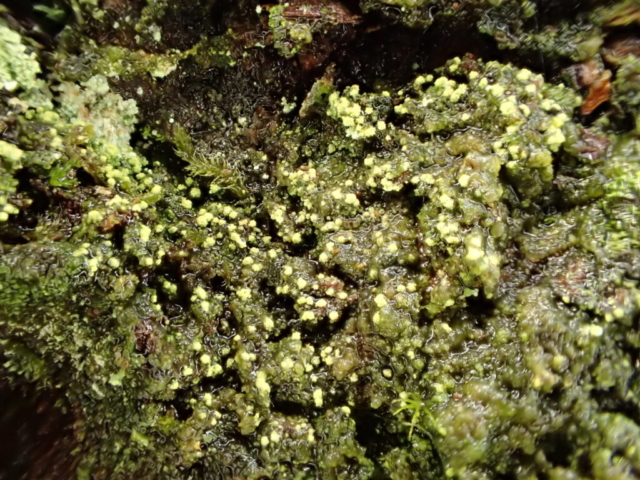It was good to have a trip to the north of Cumbria. This time we really were north of the Wall (beyond the pale?) and Pete kindly arranged a detour on the drive in so we could see Birdoswald and Roman wall remnants right by the road. Our goal was an area of woodland now in three adjacent fragments, known as Mollen Woods. This is designated as a SSSI for its slope and wet valley alder woods, with ash and hazel throughout and birch on drier ground, and is described as unenclosed parkland. Lichens are mentioned in the citation which isn’t that common. Of these we saw one (Thelotrema lepadinum) but Usnea dasopoga and Peltigera horizontalis were not seen.
The weather was forecast to be horrible but after early rain it turned out almost dry. At the start the lichens were saturated, making recognition of species we can normally do more difficult – they become swollen and often change colour. This also makes them hard to photograph.
We parked at Askerton Castle, with permission, and the five of us in team lichen walked north for a mile on the road, taking in crustose lichens on a sandstone bridge – almost the only saxicolous habitat we saw. Reaching the edge of access land we struck out across very wet ground, heading for the main woodland but looked at a couple of old alder trees on the way. Alder has naturally acidic bark so it was no surprise to encounter species that like that pH – probably the most attractive of these are the pin lichens which have tiny apothecia on stalks, represented here by Chaenotheca ferruginea and C brunneola, growing on the drier north side of the trees. There were also sheets of slightly mauve-grey Lecanactis abietina, which we checked by seeing the C+red reaction of the pruina on the numerous peg-like pycnidia, and lots of leprose and sorediate crusts which are more challenging.
As usual a well-vegetated gate detained us before entering the wood proper where we began by looking at some understorey hazel trees. Immediately we saw what would, until recently, have been straightforward Graphis scripta but this is now recognised as a complex of species so, until we get our heads around that, we will be recording these as G scripta sensu lato = “in the broad sense”. There were other crusts too – copious Coniocarpon cinnabarinum in shades of pink-red, Thelotrema lepadinum in creamy sheets, buff sorediate Pyrrhospora quernea which was sometimes fertile and squamulose Normandina pulchella. On ash there was Peltigera praetextata on the mossy trunks where we also had a flurry of excitement thinking we’d found Bryobilimbia sanguineoatra but it turned out to be the commoner Bilimbia sabuletorum when we looked at the spores later. This can have variable apothecia, anywhere from pink to red-brown to black, and being very wet looked tantalisingly like something else. It prefers alkaline substrates and as this was the only instance on ash it suggests that most of these normally base-rich trees had been acidified. On fallen rotting trunks we had Lichenomphalia umbellifera, with a thallus of minute green globules containing algae, and fungal fruiting bodies in the form of small mushrooms, and Cladonia polydactyla, blue-grey with red apothecia. Micarea alabastrites was here too, delicate-looking white flat apothecia confirmed by a C+red reaction.
In the centre of the wood was a strange fenced area of large beech trees and an infestation of rhododendron. On the east side of this was more wet alder wood which we crossed. Here there were yet more sorediate crusts on acidic bark, including tiny punctiform yellowish soralia. Could this be a candidate for the elusive yet supposedly common Lecanora jamesii? There was also Trapeliopsis pseudogranulosa on bark, usually a terricolous species. After a while, having not found many new species, we decided to head back to the cars.
There was discussion about why we were seeing the species we were, eg copious Hypotrachyna revoluta, Platismatia glauca and Parmelia in some places but missing in others. whilst other species we might expect were missing altogether, eg no acidophile Mycoblastus sanguinarius or Sphaerophorus globosus and only one Ochrolechia androgyna. Despite the habitat looking OK for them there was a general lack of canopy species, eg Usnea (sensitive to air pollution), either on the ground or when scanning upper branches, and a limited number of crustose species, though plenty of them. Suggestions for an explanation ranged from lower rainfall than elsewhere further west to lack of light getting in, as well as historic pollution – Carlisle and Dumfries are not far to the west and Newcastle to the east. The latter seems most likely, combined with past over-grazing and possible coppicing of some trees, which might mean they are not yet old enough to support well-developed lichen communities. This was supported by the odd shape of some of the hazel trees – very large-girth individual stems but few of them. Hazel is naturally multi-stemmed so one individual has a range of bark texture, from smooth young shoots to rougher old branches, so good for a variety of lichens. When this characteristic shape is lacking it usually suggests past heavy grazing, the tasty young shoots being constantly browsed off.
Hopefully we’ll be able to explore other parts of north Cumbria on future trips.
Text: Caz Walker. Photos: Caz Walker, Chris Cant, Paul Hanson, Pete Martin














